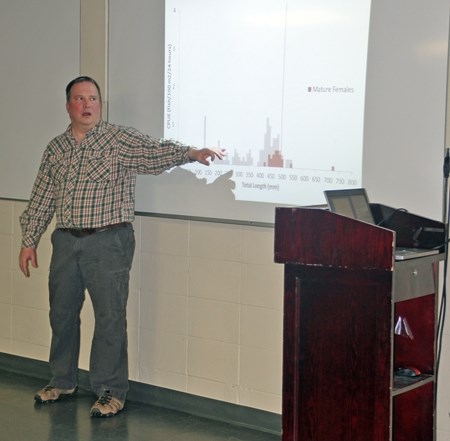Beginning in April, anglers fishing for walleye at Marie Lake may not be able to take home any of their catch.
At a public meeting held by Alberta Environment and Parks at the C2 on Jan. 13, senior fisheries biologist Dwayne Latty announced his intention to change the regulation for walleye fishing at Marie Lake from one fish over 50 centimetres to a catch and release system.
“The population is at risk of collapsing, it has not collapsed, I want to make that clear, but it is at risk of collapsing and if a population collapses it's very difficult, if not impossible, to revive it without intervention,” said Latty. “If we allow it to collapse there is actually a risk of never getting it back.”
Around 40 people, mostly anglers, were present at the meeting to raise concerns about changing regulations, telling Latty that closing one lake just puts angling pressure on other fisheries.
“In his defence that's his one job, he's the fish biologist, he's there to represent the numbers, that's it,” said Keith Hornseth, president of the Beaver River Fish and Game Association. “However, the government as a whole, and he's part of the government, they have more tools; they could do more and I feel they should.”
Latty said he agreed with anglers that closing one lake would lead to walleye fishing pressure on other lakes, but feels his options are limited, as harvest management is the only way he can ensure the species does not collapse.
“If the evidence is clear that there's an immediate need for conservation then I'm empowered to make that recommendation and bring that recommendation to the public.”
Fisheries management keeps tabs on fish populations primarily through two methods: Creel surveys and Fall Walleye Index Netting (FWIN) tests. Creel surveys collect data concerning the number of fish caught by sport fishermen and FWIN tests consists of netting fish in lakes over time to assess abundance, size distribution, age-class distribution, sex ratio, mortality and health.
Latty showed the public FWIN data that has him convinced that the walleye population capable of reproducing at Marie Lake is on the decline.
“Eating a fish is an important part of the fishing experience and if we have to go to catch and release on Marie Lake to maintain that population, that's what we'll have to do, but we'll certainly be looking to holding these guys' feet to the fire,” said Gordon Poirier, former president of the Beaver River Fish and Game Association. “They'll close a lake on one FWIN test but they wont open them until there's three or four good ones.”
Latty has already made the regulation recommendation to a provincial fisheries management roundtable. The recommendation will now go into a package to be signed off by his director, following which it heads to the Minister of Environment and Parks for approval. If approved, the regulation will come into effect on April 1, 2016.
Although most of the meeting was dedicated to discussing Marie Lake, Latty also brought up walleye regulations at Moose Lake and Cold Lake. Currently there is a regulation of one walleye over 50 centimetres at Moose Lake and three over 50 centimetres at Cold Lake. Both are set to stay the same, but Latty did indicate that Moose Lake might go to a harvest license system in the future, if angling pressure increases on that lake.
There are 33 lakes in Latty's management area with sport fish. Twenty of them have walleye, out of which seven have harvest regulations, which could go down to six if the Marie Lake regulation proposal is approved.



